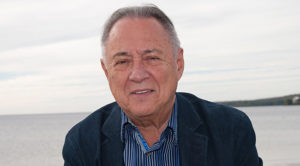Opinion: Buffy’s legacy is the real deal

By Maurice Switzer
There were only about 500 of us sitting on the infield of a baseball stadium at the foot of Bathurst Street near Toronto’s waterfront.
Orillia had evicted the Mariposa Folk Festival after the 1963 edition was invaded by an estimated 30,000 revellers – double the town’s population – who, the festival’s website records, “blocked traffic with grocery cart races, littered the streets with broken wine bottles, vandalized businesses and homes, ransacked parked cars, and bathed a statue of Samuel de Champlain in beer.”
After festival organizers lost last-minute legal appeals, they scrambled to find a site for the 1964 event. Because Toronto’s International League baseball team was on the road that August weekend, they were able to secure rental for an empty Maple Leaf Stadium barely 24 hours before the first performer was due to start singing.
Our sparse little crowd – about a quarter of the baseball team’s average home attendance of 1905 – planted ourselves on the grass infield of this makeshift outdoor concert hall, preparing to hear the latest in song stylings by some of the best-known performers of the folk music genre in North America. Tickets were $3.00 for each of a dozen concerts booked over the three-day festival.
I don’t remember hearing a young Orillia singer named Gordon Lightfoot perform his newly-released “Early Morning Rain,” and I barely recall the gruff voice and nimble blues guitar-picking of blind New York street singer Rev. Gary Davis as he belted out “Samson and Delilah.”
But I’ll never forget the haunting sound of Buffy Sainte-Marie’s tremolo vocals billowing upwards into the night sky like smoke from a blazing campfire.
After hearing a mesmerizing performance of songs that included “Now That the Buffalo’s Gone” and “Universal Soldier”, her meagre audience coaxed Buffy back for four encores. Then just 23, she was laying the groundwork for a career that would bring her an endless stream of recognition – Junos, a Golden Globe, and the first Native American Oscar for “Up Where We Belong”, 14 honourary degrees, several lifetime achievement awards, appointment to the Order of Canada, and her image on a Canadian postage stamp.
Her sung and spoken activism for Native American and anti-war campaigns was vocal and visible enough to get her on Richard Nixon’s “enemies list,” and resulted in efforts to have her blacklisted by American television networks.
Buffy Sainte-Marie was more than a singer. She created and donated educational resources like the Cradleboard Teaching Project, which increased awareness of Indigenous peoples and issues for thousands of schoolchildren across North America.
Perhaps her most important gift has been one for which she never received formal public acclaim. Few things are as important to racialized groups like Native Americans than seeing their cultures placed in the spotlight. Her current status as a role model may be in doubt, but it has been real for decades.
Hearing Sac and Fox Olympian Jim Thorpe described as perhaps the greatest athlete in history, or knowing that Wailacki tribe member Nicole Mann commanded the International Space Station are immensely important to Indigenous peoples. Historic government attempts to “kill the Indian in the child” make it even more important for Indigenous youth to have role models, people who demonstrate that success is possible for people like them.
We may never know if Buffy Sainte-Marie was born Cree, Mi’kmaq, or Italian. She may never know the truth about her true heritage, or could have fabricated a false identity for reasons only known to herself, but her life’s work and accomplishments are far too important to be swept under the politically-correct rug of blood quantum. Whether or not Buffy Sainte-Marie is a status-card Indian does not detract from her decades of achievements and contributions that helped put Indigenous peoples and issues in the public eye.
Bad people do bad things, and it should come as no surprise that good people also sometimes do bad things. Ask any parent. In this binary world of black and white, right and wrong, for and against, it sometimes helps to step back and ask: “Would I rather this had or had not happened?”
Archie “Grey Owl” Belaney – the prototypical Pretendian – deliberately used a phony Indigenous persona to become arguably Canada’s most famous environmentalist. There was no question about his authenticity. But there are dozens of others whose claim to Indigeneity are clouded in the doubt created by a vague trail of historic birth and adoption records. Some of these people have made unquestionable contributions to Indigenous advocacy in their roles as authors, academics, artists, and activists.
Whatever their personal flaws or misguided motivations, they have undoubtedly contributed to Indigenous causes. They cannot be accused of taking up the space of “real” Indians if nobody else was doing what they were doing.
On the other hand, there is no shortage of “full-blooded” Indians whose main interest in their heritage seems to be how much PST they can save when they shop at Wal-Mart.
In our cultures, even tricksters can serve a purpose.
———–

Maurice Switzer is a citizen of the Mississaugas of Alderville First Nation. He wants to be identified by his advocacy for Indigenous rights, not the number on his Certificate of Indian Status.


